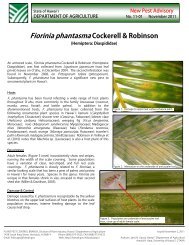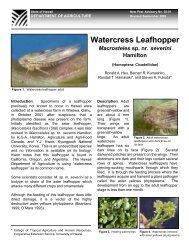Poisonous Plant Brochure
Poisonous Plant Brochure
Poisonous Plant Brochure
Create successful ePaper yourself
Turn your PDF publications into a flip-book with our unique Google optimized e-Paper software.
Other Common <strong>Poisonous</strong> <strong>Plant</strong>s:<br />
(The following is a list of other common poisonous<br />
plants. Do not assume a plant is not poisonous<br />
just because it is not listed.)<br />
African Milk Bush<br />
Akee Fruit<br />
Allamanda<br />
Anthurium<br />
Azalea<br />
Be-Still Tree<br />
Black-eyed Susan<br />
Candelabra Cactus<br />
Cassava<br />
Castor Bean<br />
Cerbera<br />
Cestrum<br />
Chinaberry<br />
Christmas Berry Tree<br />
Coral berry<br />
Cup of Gold<br />
Foxglove<br />
Gloriosa Lily<br />
Hydrangea<br />
Jimson Weed<br />
Lantana<br />
Nightshade<br />
Periwinkle<br />
Physic nut, kukui haole<br />
Red Spurge<br />
Star-of-Bethlehem<br />
Wood Rose, Hawaiian Baby<br />
Wild Mushrooms (fungus) - Mushrooms<br />
require expert identification, and may<br />
cause death.<br />
Pesticides Branch<br />
Office: (808) 973-9401<br />
Fax: (808) 973-9418<br />
Website: www.hawaiiag.org/hdoa<br />
January 2007<br />
Top Ten Inquiries<br />
About <strong>Plant</strong>s<br />
Received by the<br />
Hawaii Poison Hotline<br />
*Crown flower (Calotropis gigantea)<br />
Educate Yourself<br />
Hawaii Poison Hotline<br />
1(800) 222-1222<br />
POISONOUS PLANTS ARE<br />
ALL AROUND US<br />
Whether we go to the park, to the beach, hiking,<br />
camping, or even if we stay at a hotel, we are<br />
potentially exposed to poisonous plants. These<br />
toxic plants are often used in landscaping and as<br />
ornamental plants. Educating ourselves about<br />
the types of plants and other pests that could<br />
harm us is important not only for our health and<br />
well-being, but for our children’s as well.<br />
<strong>Plant</strong>s rank as the 4th most common type of<br />
poisoning exposure following those involving<br />
medications, household cleaning products, and<br />
health and beauty aids.<br />
<strong>Poisonous</strong> plants come in all different sizes,<br />
colors, and textures. Some poisonous plants<br />
have berries that look good enough to eat.<br />
Children are attracted to plants because of their<br />
colorful leaves and berries and fragrant flowers.<br />
Basic Rules to Follow:<br />
♦ Never eat or taste any strange fruit,<br />
seed, leaf, flower, or root.<br />
♦ Be cautious of contact with any plant<br />
you do not know, particularly those<br />
with :<br />
∗ White or milky juice or sap;<br />
∗ Rough hairy leaves;<br />
∗ Spiny fruit or seed pods;<br />
∗ Unusual shape;<br />
∗ Low-maintenance plants whose<br />
poisons make them resistant to<br />
insects.<br />
References:<br />
Scott, Susan and Thomas, Craig, <strong>Poisonous</strong> <strong>Plant</strong>s of<br />
Paradise, University of Hawaii Press, 2000.<br />
www.desert-tropicals.com<br />
www.ces.ncsu.edu<br />
www.safetyrules.health.wa.gov.au<br />
www.caf.wvu.edu<br />
www.kingherb.com<br />
www.hear.org/maps/plants/hawaii<br />
Dr. Alvin Bronstein, Medical Director of Rocky Mountain<br />
Poison and Drug Center<br />
Kapiolani Poison Prevention Program<br />
POISON PREVENTION TIPS<br />
∗ Keep all plants out of reach of young children. Even<br />
plants that are not poisonous can be harmful:<br />
⇒ They may have been sprayed with pesticides;<br />
or<br />
⇒ Children may choke on the berries, leaves, and<br />
other parts of the plant; or<br />
⇒ Children may be injured from sharp leaves or<br />
thorns.<br />
∗ Store your seeds, bulbs, and plant food out of sight<br />
and out of reach of children.<br />
∗ Learn both botanical and common names of the<br />
plants in your home and yard. Keep a list. Put the<br />
name of each plant on the bottom of the planter.<br />
Find out which ones are poisonous. You can do so<br />
by taking a piece of the plant to your local botanical<br />
garden.<br />
SAFE PLANTING TIPS<br />
∗ When you plant your garden and buy your indoor<br />
plants, make sure you place potentially poisonous<br />
or dangerous plants in areas that are out of reach<br />
of children. Even if non-poisonous, young children<br />
can choke on the berries, stems, and leaves, or<br />
may be injured from the sharp thorns or leaves.<br />
∗ Make sure you know the plants you are putting in<br />
your garden. Are they toxic or non-toxic? The<br />
leaves from 3 very common vegetables can be<br />
harmful….tomatoes, potatoes, and rhubarb.<br />
∗ Do not leave out packs of seeds. Some are<br />
poisonous and others may be coated with<br />
pesticides.<br />
∗ Keep all fertilizers and pesticides in their original<br />
containers and out of reach of children, and follow<br />
all directions provided on the label.<br />
∗ When you spray any pesticides on your plants,<br />
remember to wash your hands and to protect<br />
children and pets. There is a chemical residue left<br />
when you spray.<br />
∗ When you spray your yard or any plant, do so on<br />
calm days and always spray downwind away from<br />
yourself, pets, and other homes. Be considerate of<br />
your neighbors.<br />
∗ If you spray your lawn, do not let anyone walk<br />
across it until it is dry.<br />
∗ Be careful not to spray children’s toys, play gyms,<br />
sandboxes, bikes, or pet food dishes.
Common Name: Plumeria; pua melia; frangipani<br />
Scientific Name: Plumeria sp.<br />
Description: Small tree; leaves glossy, ovate (pointed or rounded); flowers tubular, 5lobed,<br />
white, red, yellow, pink, or combination.<br />
Mode: All parts - ingestion; dermatitis<br />
Symptoms: When eaten in large amounts, may result in vomiting and diarrhea. Milky sap may<br />
produce rash and blistering on skin contact. Frequently eaten by children because of its sweet<br />
fragrance.<br />
Common Name: Taro; kalo; coco yam *EDIBLE*<br />
Scientific Name: Colocasia esculenta<br />
Description: Herb; leaves arrowhead-shaped, long stems leading to corm; corm shaped<br />
like a top w/ small spindly roots; commonly eaten when prepared properly.<br />
Mode: All parts - ingestion; dermatitis<br />
Symptoms: When any part of this plant is eaten raw or undercooked, immediate stomach pain<br />
followed by swelling of lips, mouth, tongue, and throat. Excessive salivation & blisters may<br />
occur. Contact with taro sap/juice may cause skin redness, itching, and burning.<br />
Common Name: Oleander<br />
Scientific Name: Nerium oleander<br />
Description: Shrub or small tree; clear gummy sap; leaves long, thin, and leathery;<br />
flowers 5-parted, funnel-shaped, white, pink, red, or yellow.<br />
Mode: All parts - ingestion<br />
Symptoms: Mere lick or taste may produce nausea, vomiting, stomach pain, and cramping.<br />
This plant can cause irregular or slowed pulse resulting in generalized heart symptoms as well<br />
as dizziness, headache, confusion, and drowsiness.<br />
Common Name: Poinsettia<br />
Scientific Name: Euphorbia pulcherrima<br />
Description: Shrub; leaves large, dark green, pointed, w/ red bracts (petal-like leaves);<br />
flowers small, yellow-green at top<br />
Mode: Dermatitis; ingestion<br />
Symptoms: Skin contact may cause mild redness and irritation. Some individuals may develop<br />
swelling and blisters. Eating large amounts may result in nausea, vomiting, and diarrhea.<br />
Common Name: Crown flower<br />
Scientific Name: Calotropis gigantea<br />
Description: Evergreen shrub; leaves pale, oval w/ fuzzy texture; flowers purple or white<br />
and form small crown; usually no fruit.<br />
Mode: Ingestion<br />
Symptoms: Milky juice may irritate or burn skin; eye contact result in intense tearing & eyelid<br />
swelling. Ingestion may cause nausea, vomiting, stomach pain & cramping; irregular or slowed<br />
pulse resulting in generalized heart symptoms as well as dizziness, headache, confusion, etc.<br />
Common Name: Candlenut tree; kukui<br />
Scientific Name: Aleurites moluccana<br />
Description: Tree; leaves simple, ovate or tri-lobed; flowers small, greenish-white,<br />
in clusters; fruit round, hard, apple-shaped, brown w/ black hard seed.<br />
Mode: Ingestion; dermatitis<br />
Symptoms: All parts are poisonous, but raw seeds usually culprit causing mild to severe<br />
vomiting, abdominal cramping, and diarrhea. Watery sap on skin may cause red, itchy rash.<br />
Common Name: Mango *EDIBLE*<br />
Scientific Name: Mangifera indica; related to poison ivy.<br />
Description: Tall tree; leaves droop, lance-shaped, red then green; flowers small, numerous,<br />
ivory; fruit irregular egg-shaped, greenish-yellow, red tinge, one seed.<br />
Mode: Dermatitis<br />
Symptoms: Severity of symptoms depends on individual and amount of contact. Skin contact<br />
results in simple rash to blistering that can produce generalized swelling over entire body.<br />
Effects may be delayed. Itching and burning of lips may occur after eating unpeeled mango.<br />
Common Name: Pencil plant<br />
Scientific Name: Euphorbia tirucalli<br />
Description: Cactus-like tree; no spines; leaves small; flowers in yellow head; milky<br />
sap; branches often tangled, pencil-thick, succulent.<br />
Mode: Dermatitis; ingestion<br />
Symptoms: All parts contain corrosive milky sap. Skin contact can produce severe burns and<br />
blisters. Eye contact causes intense pain, redness, and swelling. Eating any part may result in<br />
severe stomach pain, vomiting, and diarrhea.<br />
Common Name: Angel’s Trumpet; nanahonua<br />
Scientific Name: Datura candida<br />
Description: tree-like; leaves large w/ tiny hairs; flowers dramatic, trumpet-shaped,<br />
orange or white.<br />
Mode: All parts - ingestion<br />
Symptoms: Initially, blurred vision and sensitivity to bright light, dry mouth, restlessness,<br />
disorientation, and hallucinations. Severe exposures may result in seizures, paralysis, coma,<br />
respiratory failure, and death.<br />
Common Name: Dumbcane<br />
Scientific Name: Dieffenbachia sp.<br />
Description: Erect herb; leaves large, oblong, variegated.<br />
Mode: Dermatitis; ingestion<br />
Symptoms: Biting and chewing leaf or stem may result in rapid development of mild to severe<br />
pain around the mouth followed by swelling of lips, mouth, tongue, and throat and excessive<br />
salivation. Skin exposure can produce a burning sensation, redness, and itching.








